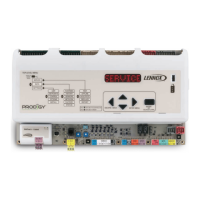Page 18
Economizer (Damper)
General
The economizer, when configured, controls
damper position, which determines how much outdoor
air is used to meet free cooling or indoor air quality
(IAQ) requirements, and
the optional power exhaust fans.
On a cooling demand, outdoor air is used for free cooling
instead of first−stage compressor(s) when outdoor air is
suitable (OAS).
Outdoor Air Suitable (OAS) LED
A yellow LED which is labeled OAS provides economizer
status. A steady yellow LED indicates that outdoor air is
suitable for free cooling. A flashing yellow OAS light indi-
cates the IAQ sensor requires outdoor air. (A flashing yel-
low LED can also mean that the economizer dampers are
open to bring in fresh air while a compressor is on.) If the
economizer is already operating, a flashing yellow OAS
light indicates the IAQ sensor requires more outdoor air
than is suitable for free cooling.
DIP Switch Settings
The DIP switch setting determines the mode used to en-
able free cooling. The DIP switch also has a mode to set
the damper minimum position and test damper operation.
DIP switch is factory−set when the economizer is factory−
configured.
Free Cooling Discharge Air Setpoint
When outdoor air conditions are suitable and economizer
is set to provide free cooling, dampers will modulate to
achieve a discharge air temperature of 55°F (13°C) de-
fault. This setpoint is adjustable between 45° and 65°F.
The setpoint can also be automatically increased when
outdoor or return air temperatures drop. See Outdoor Air
Reset and Return Air Reset in the Discharge Air Control
section in the advanced setup instructions. These settings
are not accessible through the Prodigy display at this time.
The unit does not have to be operating in discharge air
cooling mode to adjust the setpoint, or to use setpoint re-
set.
During free cooling operation, the damper modulates to its
maximum position where it remains for at least 3 minutes.
If the damper has been continuously in this position for at
least three minutes, then a second stage cooling demand
will be allowed to turn on the first stage of mechanical cool-
ing. While the mechanical cooling is on, the damper is held
to its maximum position, and does not modulate until the
second stage demand is satisfied. On a third stage cooling
demand, the second stage of mechanical cooling will be
turned on.
Outdoor Air Suitability
There are six options available to determine outdoor air
suitability (OAS) for free cooling. See table 5. Economizer
settings are shown for each mode in figure 5.
The appropriate sensors are provided when the economiz-
er is factory−configured. When the economizer is field−con-
figured, the ODE mode requires additional field−provided
sensor(s). See table 5. The TEMP mode uses sensors pro-
vided with all units.
Table 5. Free Cooling Options
Free cooling mode
DIP SW
positions
MODE
Selection
CONTROL
Selection
OAS setpoint calc if CONTROL
is SENSIBLE
Temperature offset 1,2 to TMP TEMP OFFSET OAT<RAT−OFFSET (0 to 40 F)
Temperature setpoint 1,2 to TMP TEMP OAT STPT OAT<OAT STPT (41 to 70 F)
Remote 1,2 to TMP TEMP ANY OAS sent by network.
Enthalpy differential (Potentiometer set to DIFF) 1,2 to ODE ENTH N/A ODE<IDE
Enthalpy setpoint (Potentiometer set to A−D) 1,2 to ODE ENTH N/A ODE<POT
Global input 1,2 to GLO GLOBAL N/A GLO input

